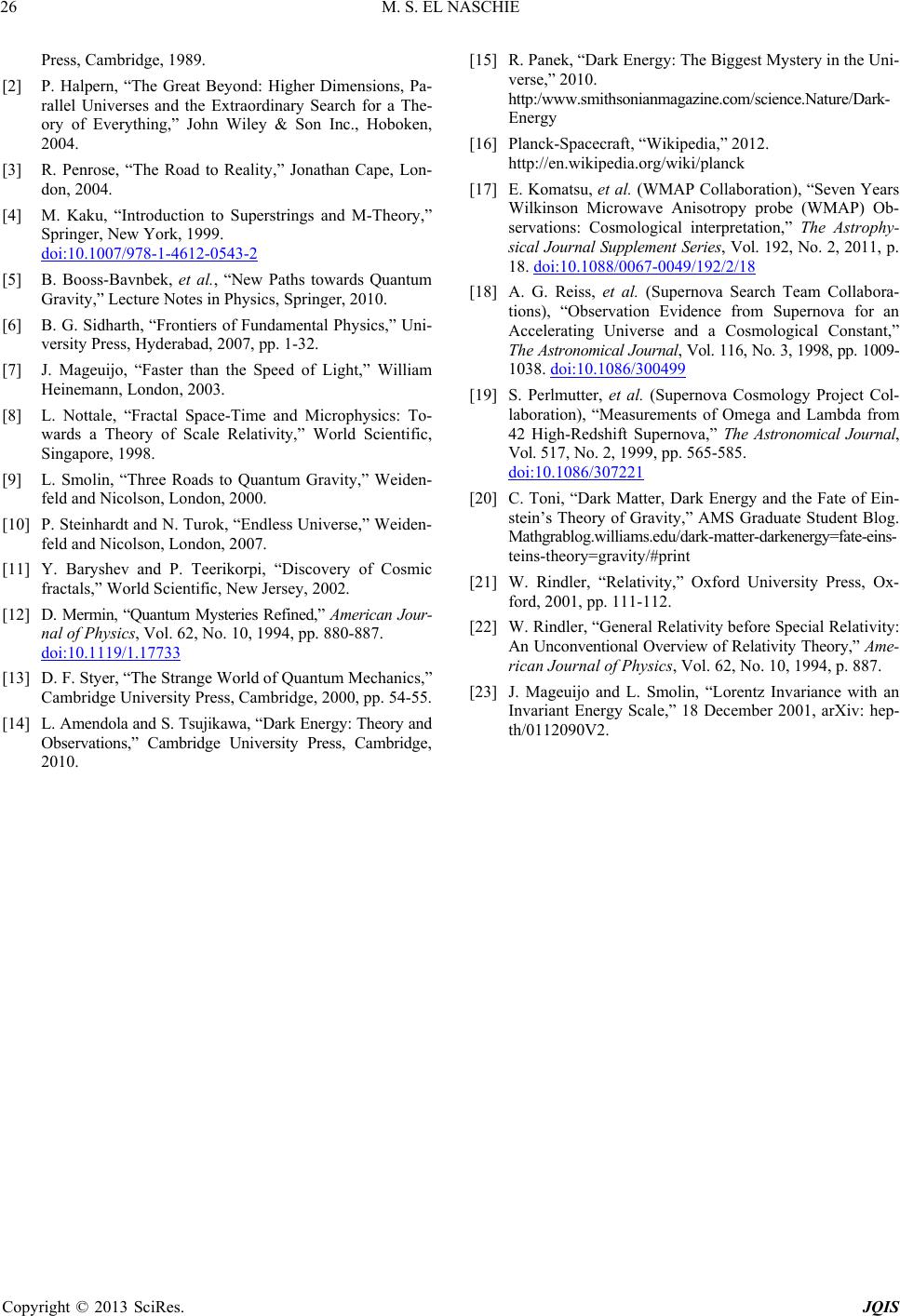
M. S. EL NASCHIE
Copyright © 2013 SciRes. JQIS
26
Press, Cambridge, 1989.
[2] P. Halpern, “The Great Beyond: Higher Dimensions, Pa-
rallel Universes and the Extraordinary Search for a The-
ory of Everything,” John Wiley & Son Inc., Hoboken,
2004.
[3] R. Penrose, “The Road to Reality,” Jonathan Cape, Lon-
don, 2004.
[4] M. Kaku, “Introduction to Superstrings and M-Theory,”
Springer, New York, 1999.
doi:10.1007/978-1-4612-0543-2
[5] B. Booss-Bavnbek, et al., “New Paths towards Quantum
Gravity,” Lecture Notes in Physics, Springer, 2010.
[6] B. G. Sidharth, “Frontiers of Fundamental Physics,” Uni-
versity Press, Hyderabad, 2007, pp. 1-32.
[7] J. Mageuijo, “Faster than the Speed of Light,” William
Heinemann, London, 2003.
[8] L. Nottale, “Fractal Space-Time and Microphysics: To-
wards a Theory of Scale Relativity,” World Scientific,
Singapore, 1998.
[9] L. Smolin, “Three Roads to Quantum Gravity,” Weiden-
feld and Nicolson, London, 2000.
[10] P. Steinhardt and N. Turok, “Endless Universe,” Weiden-
feld and Nicolson, London, 2007.
[11] Y. Baryshev and P. Teerikorpi, “Discovery of Cosmic
fractals,” World Scientific, New Jersey, 2002.
[12] D. Mermin, “Quantum Mysteries Refined,” American Jour-
nal of Physics, Vol. 62, No. 10, 1994, pp. 880-887.
doi:10.1119/1.17733
[13] D. F. Styer, “The Strange World of Quantum Mechanics,”
Cambridge University Press, Cambridge, 2000, pp. 54-55.
[14] L. Amendola and S. Tsujikawa, “Dark Energy: Theory and
Observations,” Cambridge University Press, Cambridge,
2010.
[15] R. Panek, “Dark Energy: The Biggest Mystery in the Uni-
verse,” 2010.
http:/www.smithsonianmagazine.com/science.Nature/Dark-
Energy
[16] Planck-Spacecraft, “Wikipedia,” 2012.
http://en.wikipedia.org/wiki/planck
[17] E. Komatsu, et al. (WMAP Collaboration), “Seven Years
Wilkinson Microwave Anisotropy probe (WMAP) Ob-
servations: Cosmological interpretation,” The Astrophy-
sical Journal Supplement Serie s, Vol. 192, No. 2, 2011, p .
18. doi:10.1088/0067-0049/192/2/18
[18] A. G. Reiss, et al. (Supernova Search Team Collabora-
tions), “Observation Evidence from Supernova for an
Accelerating Universe and a Cosmological Constant,”
Th e Astronomical Journal, Vol. 116, No. 3, 19 98, pp. 1009-
1038. doi:10.1086/300499
[19] S. Perlmutter, et al. (Supernova Cosmology Project Col-
laboration), “Measurements of Omega and Lambda from
42 High-Redshift Supernova,” The Astronomical Journal,
Vol. 517, No. 2, 1999, pp. 565-585.
doi:10.1086/307221
[20] C. Toni, “Dark Matter, Dark Energy and the Fate of Ein-
stein’s Theory of Gravity,” AMS Graduate Student Blog.
Mathgrablog.williams.edu/dark-matter-darkenergy= fate-eins -
teins-theory=gravity/#print
[21] W. Rindler, “Relativity,” Oxford University Press, Ox-
ford, 2001, pp. 111-112.
[22] W. Rindler, “General Relativity before Special Relativity:
An Unconventional Overview of Relativity Theory,” Ame-
rican Journal of Physics, Vol. 62, No. 10, 1994, p. 887.
[23] J. Mageuijo and L. Smolin, “Lorentz Invariance with an
Invariant Energy Scale,” 18 December 2001, arXiv: hep-
th/0112090V2.